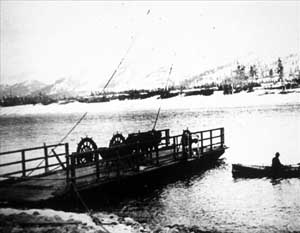The Inchelium-Gifford Ferry -- also called the Gif -- is operated on Lake Roosevelt by the Colville Confederated Tribes on behalf of the Bureau of Indian Affairs. The run connects Inchelium with State Route 25 in Stevens County and has been in operation since 1898.
In 1898, a ferry began operating across the Columbia River between Gifford in Stevens County and the Colville Reservation community of Inchelium in Ferry County. A Congressional decision in 1896 to open the reservation to mineral development by non-Indians resulted in increase traffic across the river from the direction of Colville.
In 1939 and 1940, water from Lake Roosevelt behind Grand Coulee Dam rose and inundated Inchelium and Gifford. A new Inchelium grew up on higher ground a few miles away and the ferry shifted its landings to the new locations. The ferry service continued as a private enterprise until 1974 when the business closed as unprofitable. This compelled travelers to drive 30 miles to the Keller Ferry to cross the river. The Colville Confederated Tribes and the Bureau of Indian Affairs asked Congress for funding for a permanent ferry. The BIA arranged for a tug and barge to move autos across the lake.
In 1981, Fisherman’s Boat Shop in Everett completed the Columbian Princess on a $1.7 million contract with the Bureau of Indian Affairs. The 120-foot-long hull was towed through the Strait of Juan de Fuca to the Columbia River where it transited five sets of locks to Pasco. At Pasco in July, the ferry, with an engine and screw at each end, was placed on wheels and trucked overland, at four to six miles an hour, 108 miles to Lincoln in Lincoln County. The unusual convoy, 42 feet wide, passed over four highway bridges and 54 culverts, often creating an odd image in a sea of ripening wheat.
In 1994, the tribe took over operation of the ferry from the family that had the BIA contract.
On the Columbian Princess there was no shelter for foot passengers and the wheel house sat on legs straddling the car deck. No fares are charged for the six-minute crossing. During periods of low water the ferry just noses up on the shore like a landing craft to load and discharge vehicles and passengers.

